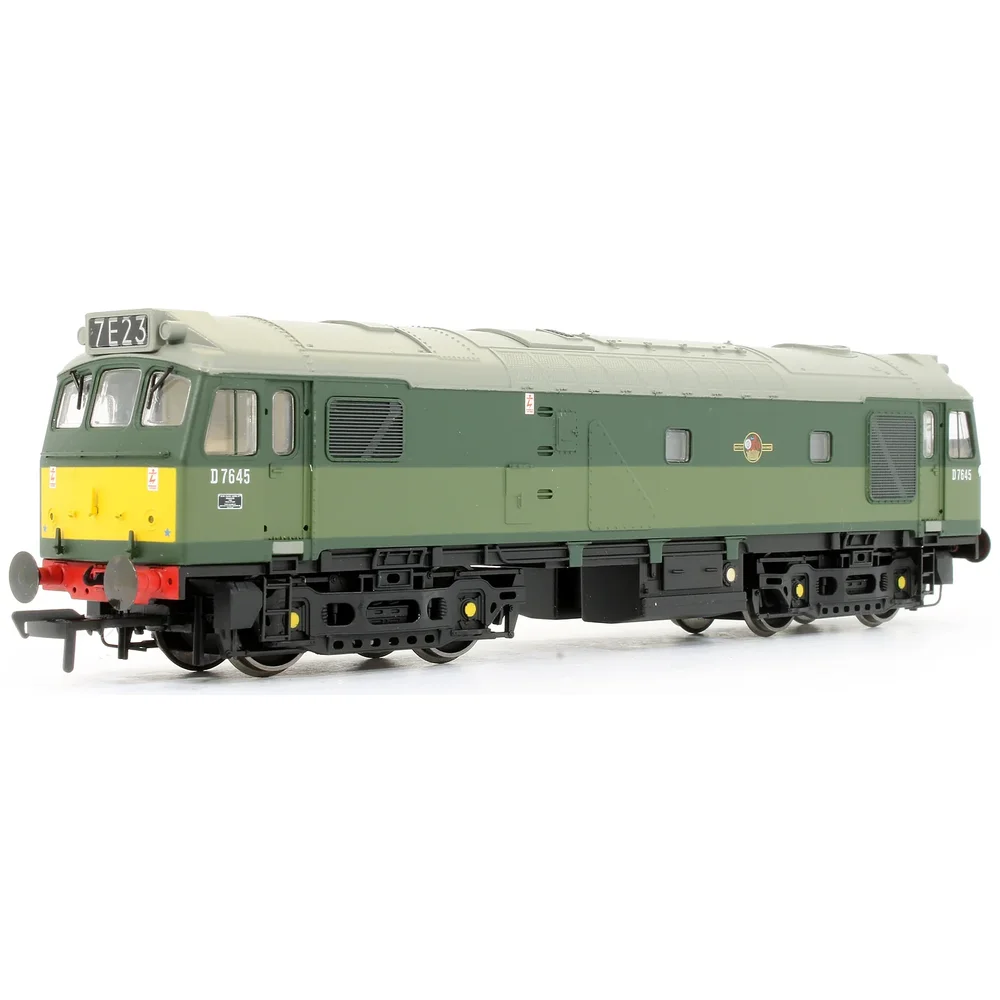Bachmann 32-400
British Rail Class 25/3 D7645 British Railways Two-Tone Green
Tooling
Bachmann introduced its first British Rail Class 25 diesel-electric locomotive in OO gauge in 2001. This model represented a significant step forward from earlier offerings by other manufacturers, providing modellers with a more accurate and detailed rendition of the Sulzer Type 2 locomotive, widely known as the “Rat.” The tooling catered to the popularity of the Class 25 among enthusiasts of 1960s–1980s British Rail operations.
Tooling Features
- Scale: OO gauge (1:76)
- Construction: Injection-moulded plastic bodyshell with diecast metal chassis for weight and stability
- Detailing: Separate handrails, lamp irons, etched side grilles, bufferbeam detail packs, painted cab interiors with crew figures, flush glazing, chemically blackened wheels
- Couplings: Tension-lock couplers in NEM pockets
- Minimum Radius: Second radius curves (approx. 438mm)
Mechanical & Electrical
- Drive: Centrally mounted can motor with twin flywheels driving all axles
- Pickups: All wheels for reliable current collection
- Weighting: Integrated diecast chassis for improved adhesion
- Lighting: Illuminated headcode panels (non-directional on DC)
- Recommended running-in: Around one hour each direction at moderate speed
DCC Capability
DCC Ready with an 8-pin socket and provision for a 28mm round speaker for sound upgrades. This was a notable feature at the time, making conversion straightforward for digital control.
Liveries Produced
- BR Green with early emblem (1948–1957)
- BR Green with late crest (1957–1972)
- BR Two-Tone Green variants
- BR Blue (1965–1990)
- Special editions such as D7672 “Tamworth Castle” in Two-Tone Green
Reviews & Commentary
The 2001 Class 25 was praised for its weight, smooth running, and improved detailing compared to older models. Reviewers highlighted the accurate bodyshell shape and separately fitted parts, though some noted limitations in lighting and the absence of factory sound options (common for the era). Enthusiasts on forums and early social media regarded it as a “go-anywhere workhorse” suitable for mixed-traffic layouts. Video reviews and later retrospectives often describe it as one of Bachmann’s better early diesel models, with strong haulage capability and reliable performance.
Interesting Notes
- Tooling represented primarily Class 25/3 variants, identifiable by roof vent arrangements
- Body removal was simple, aiding decoder installation
- Set a benchmark for mid-range OO gauge diesels in the early 2000s, preceding later retoolings in 2003 and 2006
Class & Prototype
- Class: British Rail Class 25/3
- Traction: Diesel
- Transmission: Electric
- Built: 1965-1967
- Total Built: 327
No prototype found.
Operator & Livery
- Operator: British Railways
- Livery: Two-Tone Green
British Railways transformed Britain's fragmented rail network into a unified national system following nationalisation on 1st January 1948. Created from the "Big Four" companies under the Transport Act 1947, BR operated most of Great Britain's railways until rebranding as British Rail in 1965, managing over 20,000 route miles and inheriting nearly 20,000 locomotives of diverse designs.
The organisation pioneered standardisation through its revolutionary BR Standard locomotive programme (1951-1960), producing 999 advanced steam engines under Robert Riddles' direction. These included the versatile Britannia Pacifics, mighty 9F freight engines, and mixed-traffic classes that incorporated the best features from all predecessor companies. The 1955 Modernisation Plan accelerated diesel and electric traction development, creating fascinating mixed-traction operations.
Notable achievements included establishing unified locomotive classification systems, introducing distinctive corporate liveries, and managing the complex transition from steam to modern traction. BR's six regional structure preserved operational diversity whilst enabling standardisation of practices, signalling, and rolling stock that had eluded private enterprise for over a century.
The BR era represents steam traction's final flowering alongside emerging diesel technology, creating unparalleled locomotive variety. Today, this heritage remains highly popular with railway enthusiasts through extensive preserved fleets, heritage railway operations, and comprehensive model ranges from manufacturers like Hornby, Bachmann, and Dapol, making BR subjects essential for authentic post-war British railway modelling across all scales.
